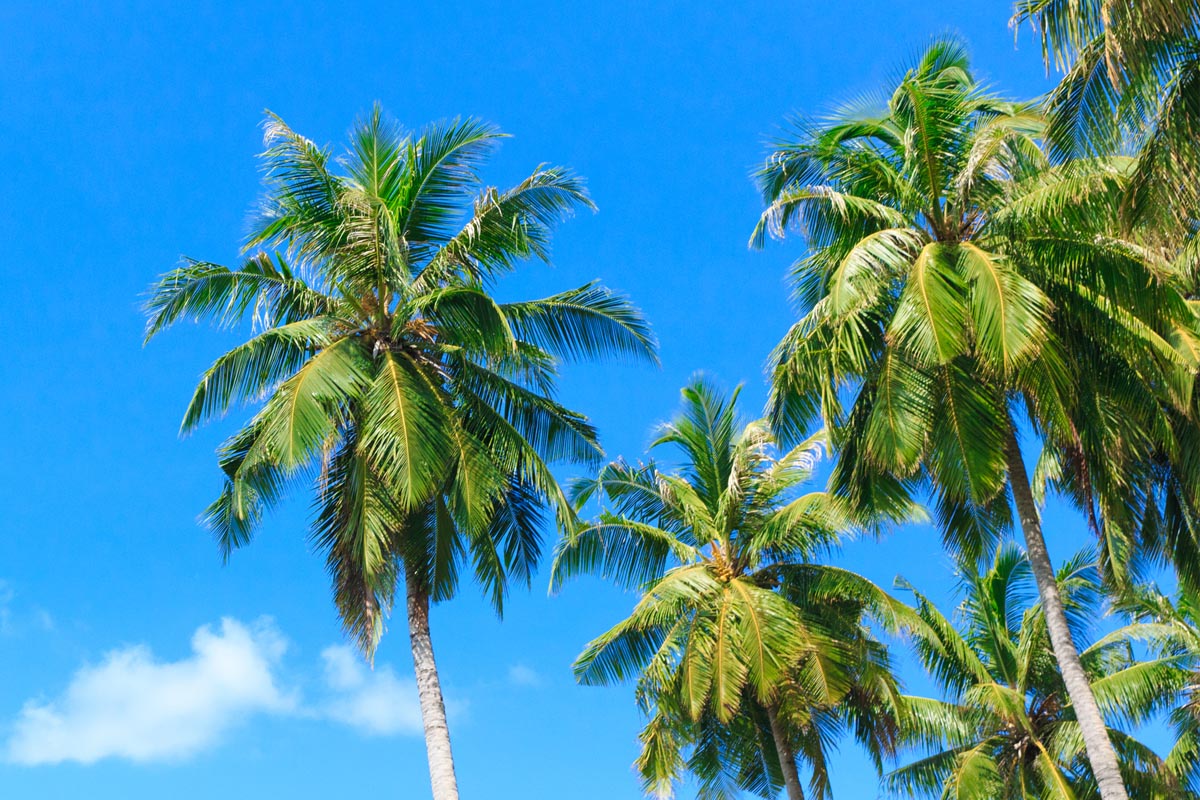

We may earn revenue from the products available on this page and participate in affiliate programs. Learn More ›
Tropical islands, remote jungles, desert oases, and Miami have a common visual: palm trees. In tropical and subtropical regions around the world, palms are familiar and useful plants. People have used the trees for food, fuel, and fiber since the dawn of time, plus palm trees look great in vacation photos or in a backyard oasis. But, with so many types of palm trees in the world, you might not have thought of actually growing one, or you might have wondered what type of palm tree to choose. If you live in a warm, sunny location, whether humid or arid, there is a palm tree for you.
The botanical family that includes palm trees, Arecaceae, is more closely related to grasses, bamboos, lilies, and onions than to trees. These woody herbaceous plants encompass more than 2,500 different palm tree species. According to the Annals of Botany, palms grow in warm, sunny places on every continent except Antarctica. Some of the more cold-hardy types of palm trees grow surprisingly well outdoors in mild, temperate areas, and numerous species make wonderful houseplants as well. Here, we will explore nine types of palm trees that thrive in warm, sunny climates.
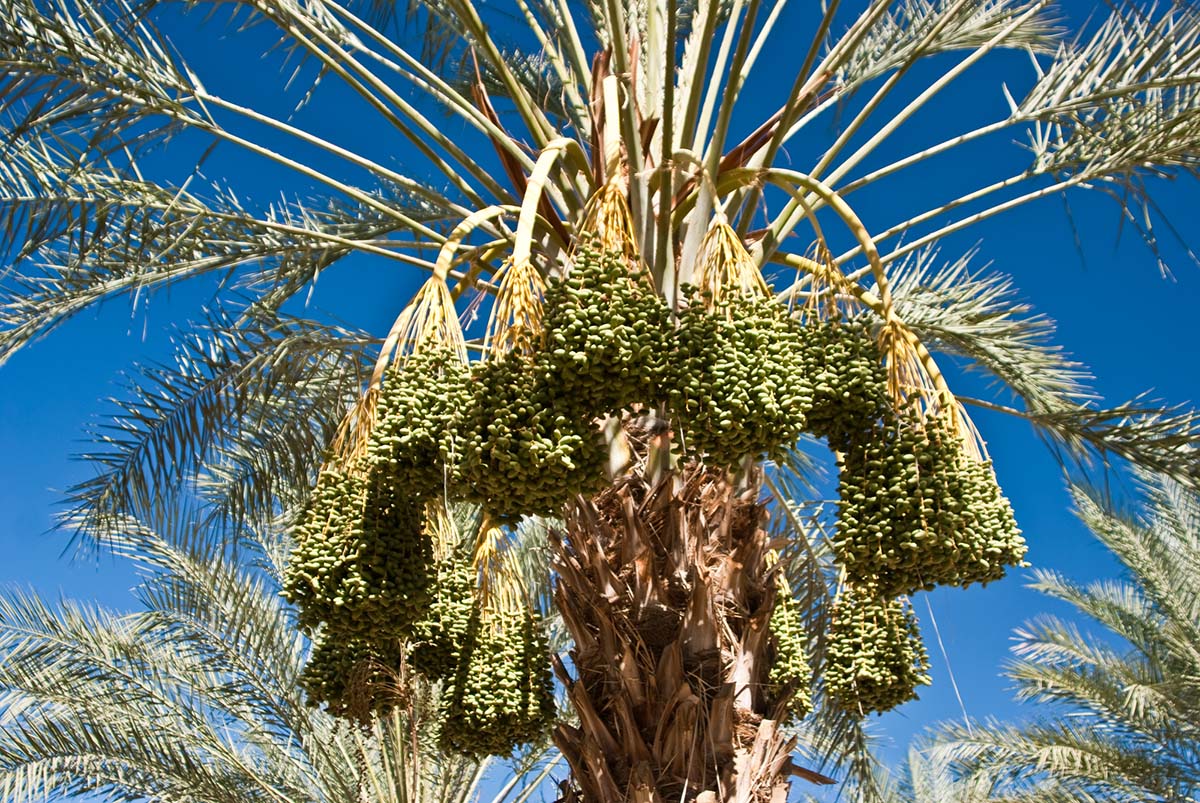
1. Date Palms (Phoenix spp.)
True date palms (P. dactylifera) have been cultivated in the Middle East, North Africa, and the Mediterranean since ancient times for their sweet, edible fruits. In the United States, dates grow for commercial use in Arizona, California, and Nevada. Some cultivars can survive in sheltered locations up to zone 8, and still produce fruit most years.
Other “date palms,” or Phoenix palms, are closely related to the true Date Palm but do not produce comparable fruit. All Phoenix palms are either male or female. These palms all have similar feathery foliage and grow in arid locations. Some grow quite large, and others stay small. The Pygmy date palm, P. roebelenii, is a great choice for houseplant enthusiasts who can provide the plant with lots of natural sunlight.
USDA Zones: 9 to 11
2. Zombie Palm Trees (Zombia antillarum)
Zombie palm is a beautiful landscape and garden palm, with fan-like foliage and trunks that appear thatched and wrapped. But beware of the protruding needles that spiral up the trunk, which can easily puncture the skin. The spines form as the remnants of old leaf stems that have died back as new foliage grew above. This small, clumping palm works best in a location where it can be seen, but not touched.
Zombie palm is native to the West Indies island of Hispaniola. It is by no means common, but occasionally appears growing on dry, forested slopes and ridges. Zombie palms are highly drought tolerant and grow best in sandy soil, but prefer periodic watering in the landscape for best performance. This palm produces white flower panicles among the fronds at the top of the plant, which are followed by white fruit clusters.
USDA Zones: 10 to 11
3. Windmill palm (Trachycarpus fortunei)
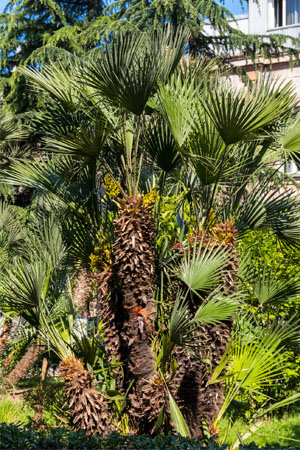
Windmill palm, also known as Chinese windmill palm and Chusan palm, is one of the most cold-hardy types of palm trees. This native of East Asia grows slowly to 25 feet tall and 10 feet wide, even in areas where winter temperatures reach well below freezing. It has a compact, dark green crown and a graceful trunk accented by fine black fibers.
Gardeners in cool climates who want to add a tropical touch to their landscape will find the windmill palm an excellent choice. It grows best in full sun and well-draining soil. This palm pairs well with hardy hibiscus, canna, ginger, and other cold-hardy tropical plants.
USDA Zones: 7 to 11
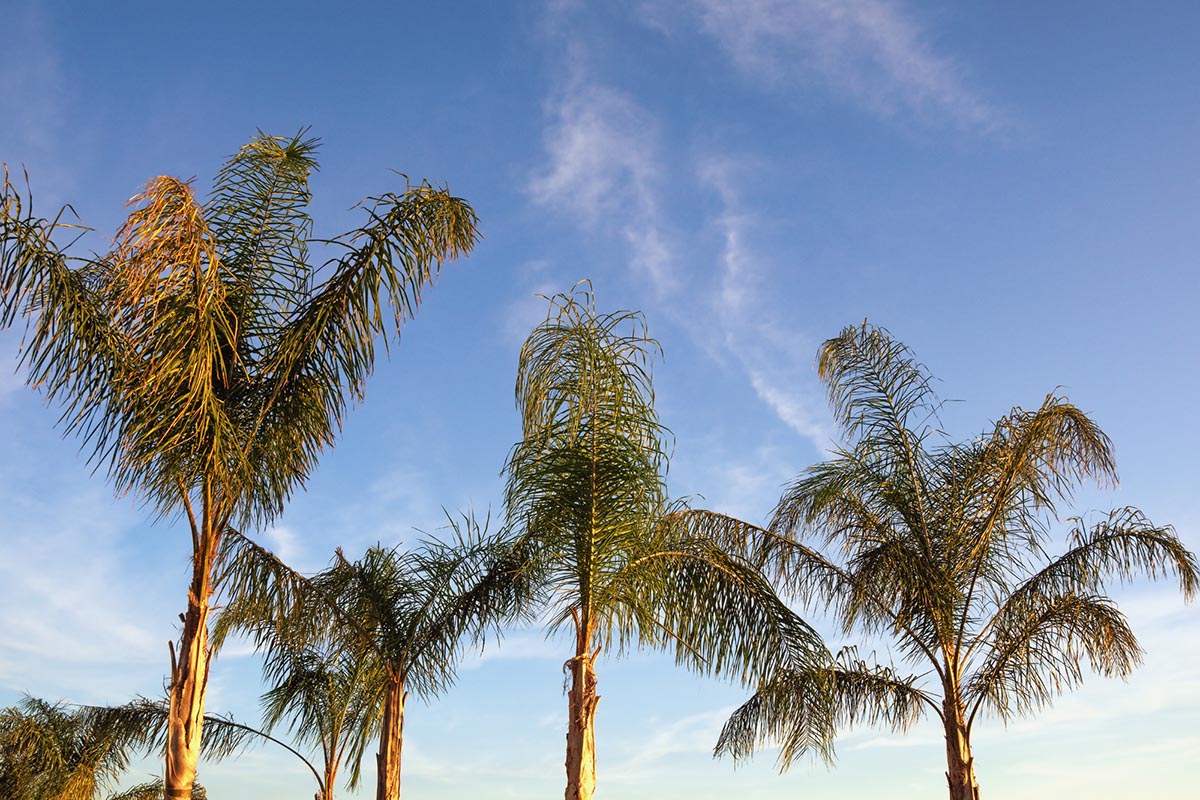
4. Foxtail Palm (Wodyetia bifurcata)
Foxtail palm is a popular landscape specimen grown for its beautiful plume-like fronds, self-cleaning habit, and compact, symmetrical form. The palm grows on a solitary smooth gray trunk to about 30 feet tall and 15 feet wide. After pollination of the flowers, foxtail palm produces large orange fruits, adding to its ornamental value.
Foxtail palms grow rapidly. They perform best when planted in soil with a liberal amount of organic matter added to the hole and then fertilized regularly. The palms can handle moderate drought as they begin to mature but prefer consistent moisture. Although other palm trees require pruning of old, brown fronds to maintain a clean appearance, old foliage simply falls off Foxtail palm trees.
USDA Zones: 10 to 11
5. Caranday palm (Copernicia alba)
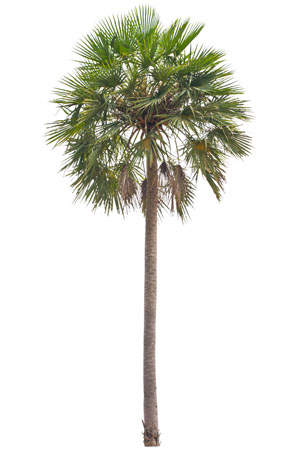
This South American native palm tree is a slow grower with a notoriously hard trunk that has been used for fences and even telephone poles. Also known as wax palm, its leaves produce a wax that has gone into making candles, lipstick, and car wax.
In the wild, Caranday palm grows as tall as 70 feet. In its native range, it often forms large, single species woodlands. But in the landscape, it averages about 30 feet tall and 15 feet wide. Caranday palm grows a solitary trunk with fan-shaped leaves that reach approximately 2 feet wide.
USDA Zones: 9 to 11
6. Spindle Palm (Hyophorbe verschaffeltii)
Spindle palm comes from the Mascarene Islands of the Indian Ocean, where it grows naturally in well-draining, sandy soil. This slow-growing palm reaches a height of 20 or 25 feet in the landscape, with 6- to 10-foot fronds. The solitary gray, ringed trunk is thickest at the midpoint. The flowers emerge as white- or cream-colored, and the fruit ripens from orange to red.
This is an excellent palm to use as a landscape focal point, with or without underplantings of accent flowers and foliage. Spindle palms come as houseplants and perform best indoors when they receive plenty of light and good air circulation.
USDA Zones: 9b to 11
7. King Palm (Archontophoenix spp.)
King palm is the name given to six closely related palm tree species, all of which are native to Australia. The most common of the group, and one of the most popular palms in tropical and subtropical landscaping, is A. cunninghamiana.
King palm is a fast-growing type of palm tree that can reach 40 feet or taller and 15 feet wide. It has a solitary, smooth gray-brown and ringed trunk plus gracefully arching fronds of bright green. In commercial and residential landscapes, king palms often grow in groups of two or three plants. King palms also can work as houseplants but can prove difficult to grow indoors.
USDA Zones: 9b to 11
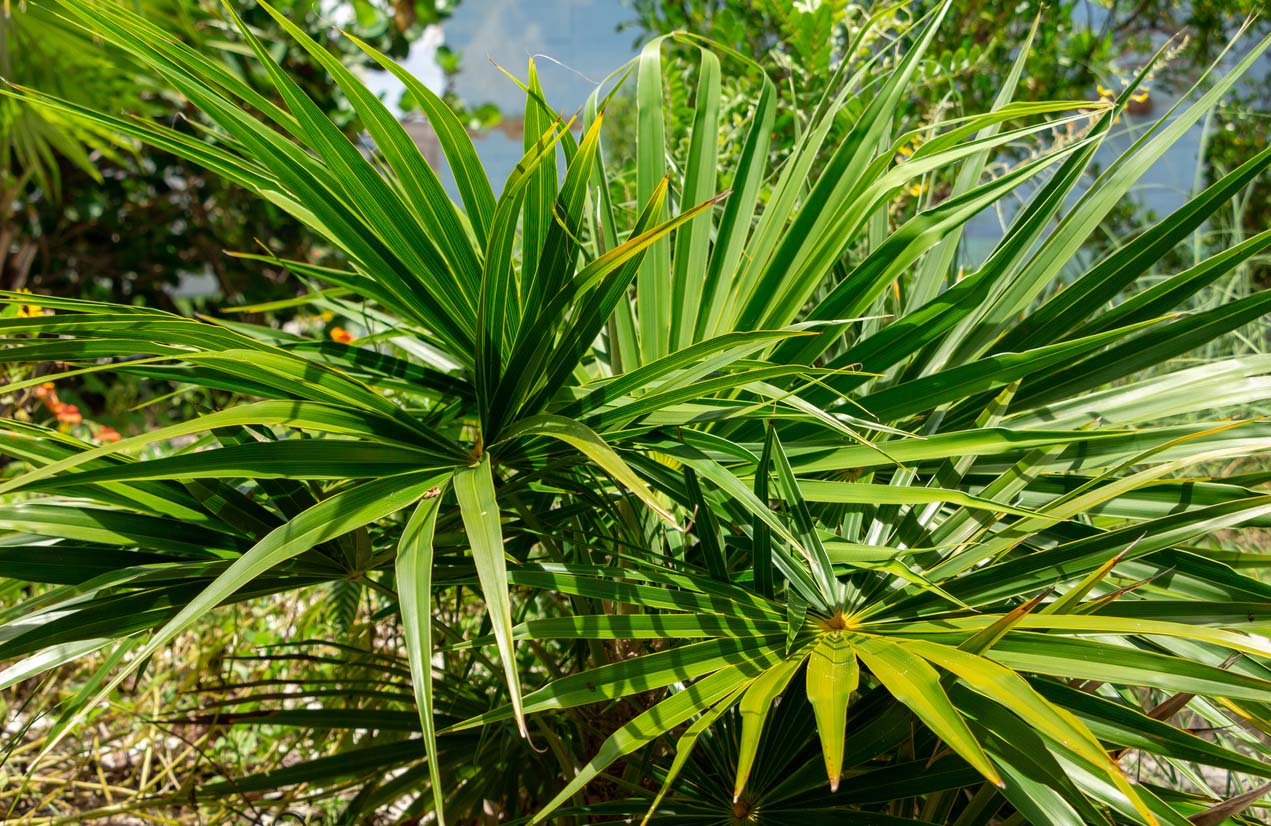
8. Florida Thatch Palm (Thrinax radiata)
This slow-growing palm with fan-shaped leaves is native to South Florida and many Caribbean islands. The Florida thatch palm eventually reaches 20 feet tall and 10 feet wide at maturity. It tolerates drought and prefers sandy soils that drain well.
The Florida thatch palm’s small size and slow growth rate make it an ideal choice for small spaces. It works well as a screening plant because of its slow growth rate and bushy habit while young. This plant serves wildlife as a host plant for the monk skipper butterfly and a food source and nesting site for birds, improving the native wildlife habitat.
USDA Zones: 10 to 11
9. Triangle Palm (Dypsis decaryi)
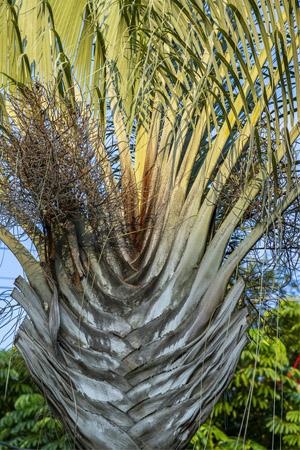
Triangle palm gets its name from the triangular intersection of emerging fronds at the top of its trunk. This unusual growth habit is accentuated by the vertical stacking of fronds, one above the other, as new foliage emerges directly above the old foliage in three vertical ranks.
Triangle palm grows at a moderate rate for palms on a solitary trunk. By maturity, it reaches an average size of 30 feet tall and 15 feet wide. The blue-green fronds can grow to 10 feet long. A native of poor soils in southern Madagascar, triangle palm thrives in dry conditions. The small yellow flowers give way to 1-inch, egg-shaped green fruits that ripen to white. Triangle Palm makes a nice landscape accent or specimen plant.
USDA Zones: 10 to 11
